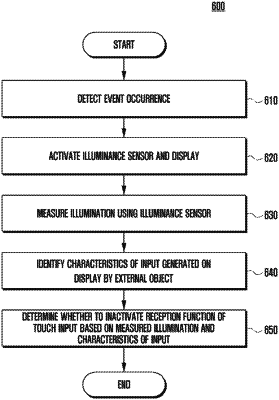| CPC G06F 3/0418 (2013.01) [G06F 21/32 (2013.01); G09G 3/2096 (2013.01); G09G 2360/144 (2013.01)] | 15 Claims |

|
1. An electronic device comprising:
a housing including a first surface and a second surface facing the first surface;
a display disposed on at least a part of the first surface;
a proximity sensor disposed between the display and the second surface;
an illuminance sensor; and
a processor connected to the display and the illuminance sensor operatively,
wherein the processor is configured to:
activate the display and the illuminance sensor in response to an occurrence of an event,
measure an illumination of an area in which the electronic device is disposed using the illuminance sensor,
identify characteristics of an input generated on the display by an external object, the characteristics of the input generated on the display comprising a size of a contact area between the external object and the display and a number of contact areas between the external object and the display, and
determine whether to inactivate a reception function of a touch input on at least a partial area of the display based at least in part on the measured illumination, the size of a contact area between the external object and the display, and the number of contact areas between the external object and the display, without the use of the proximity sensor.
|